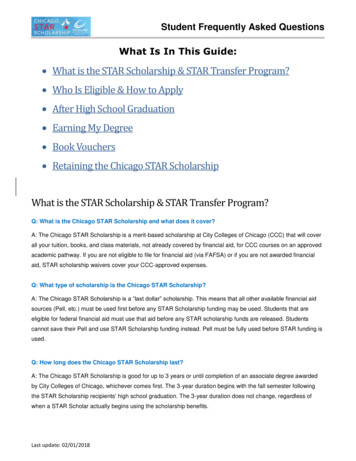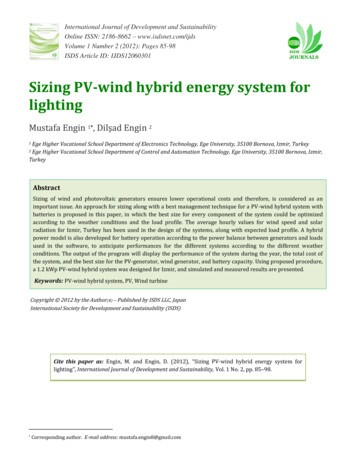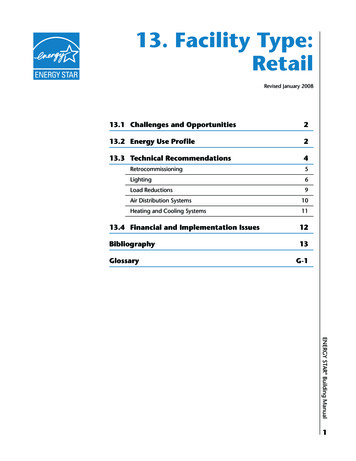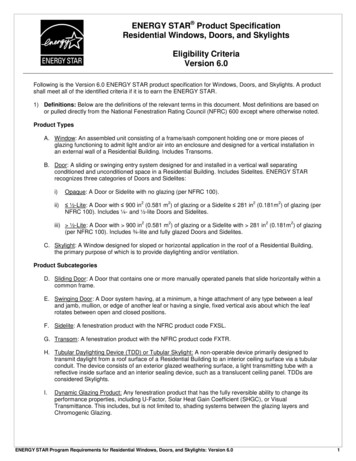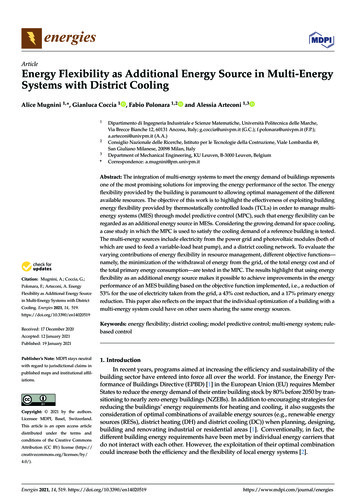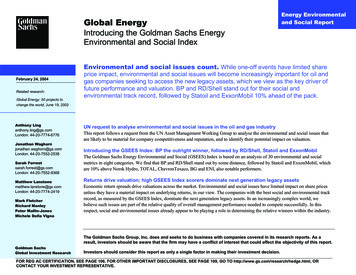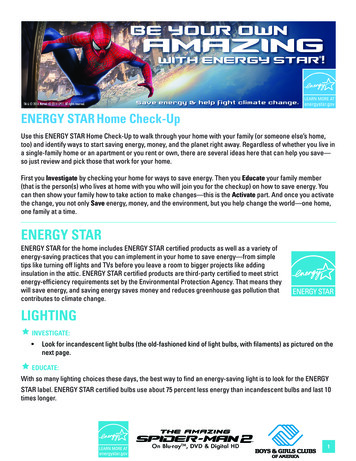
Transcription
ENERGY STAR Home Check-UpUse this ENERGY STAR Home Check-Up to walk through your home with your family (or someone else’s home,too) and identify ways to start saving energy, money, and the planet right away. Regardless of whether you live ina single-family home or an apartment or you rent or own, there are several ideas here that can help you save—so just review and pick those that work for your home.First you Investigate by checking your home for ways to save energy. Then you Educate your family member(that is the person(s) who lives at home with you who will join you for the checkup) on how to save energy. Youcan then show your family how to take action to make changes—this is the Activate part. And once you activatethe change, you not only Save energy, money, and the environment, but you help change the world—one home,one family at a time.ENERGY STARENERGY STAR for the home includes ENERGY STAR certified products as well as a variety ofenergy-saving practices that you can implement in your home to save energy—from simpletips like turning off lights and TVs before you leave a room to bigger projects like addinginsulation in the attic. ENERGY STAR certified products are third-party certified to meet strictenergy-efficiency requirements set by the Environmental Protection Agency. That means theywill save energy, and saving energy saves money and reduces greenhouse gas pollution thatcontributes to climate change.LIGHTING INVESTIGATE: Look for incandescent light bulbs (the old-fashioned kind of light bulbs, with filaments) as pictured on thenext page. EDUCATE:With so many lighting choices these days, the best way to find an energy-saving light is to look for the ENERGYSTAR label. ENERGY STAR certified bulbs use about 75 percent less energy than incandescent bulbs and last 10times longer.1
ey.nelsntsdENERGY STAR certified light bulbscome in all shapes and sizes, includingBENEFITSOF ENERGY STAR CERTIFIEDCompact Fluorescent Light BulbsConsiderwhen purchasing(CFLs)theseandbenefitsLight EmittingDiode ENERGY(LED) STAR certifiedbulbs and fixtures.bulbs. Both look different than oldbulbsuse a thenewerLongLife –becauseBulbs that theyhave earnedENERGY STAR last 6 to 25timeslongerthanstandardincandescentlight bulbs—convenienttechnology than regular light bulbs—for youhard-to-reachfixtures.Notethatwhilemight be able to tell they’remostCFLsENERGY STARcertified fixtures come with pin-based CFLs or LEDs built in forif they look swirly, but I wouldn’t try tolong lasting, hard-wired energy savings, some certified outdoorguess.forthe ENERGYfixturesofferJusttheir lookenergyefficiencybenefitsSTARthrough the uselabel andandnomotionmatterthe technologyof photocellssensors,and are compatible withincandescentbulbsin theseyou will begettinga cases.bulb that meetsstrictguidelinesformaximumenergyHigh Quality – ENERGY STAR certified fixturesand bulbs offer theefficiency.sameamount of light as incandescent or halogen lighting, whileLIGHTINGSame Amount of Light, Fewer Watts – ENERGY STAR certifiedbulbs provide the same amount of light, or lumens, as traditionalbulbs, but use a smaller amount of energy, or watts. To findthe right ENERGY STAR certified bulb for your needs, comparelumens on the packaging.For example, if you are looking for a light bulb that gives off thesame amount of light as a 60W incandescent bulb, look for anENERGY STAR certified bulb that puts out 800 lumens or more(see table below).IncandescentLight BulbsMinimumLight OutputCommon ENERGYSTAR Certified LightBulbsWATTSLUMENSWATTSa trueand naturalcolor withoutflicker, hum, or buzz providingENERGYSTARalso meanshighthequality40450of their infamous fluorescent predecessors.and performance. Bulbs with the60800Safetyand Reliability– ENERGYSTARcertified light bulbs mustENERGYSTAR labelhaveundergone751,100be extensiveUL listed for firesafetyto(UnderwritersInc.).testingmake sureLaboratories,they1001,600ENERGY STAR certified lighting runs cooler, providing the samenot only save energy, but they alsoamount of light as incandescent bulbs, but only producing a1502,600performENERGYSTAR’sstrictquarterof the properly.heat. All lightingmodelsare testedand meet strictperformancerequirementsensureENERGYbulbsmake it easierto light upspecificationsfor energyefficiency andquality thatand comewith aSTARTocertifiedBrightnesscomparelightbulbs2- or3-year warranty.quickly,don’t flicker or hum, and maintain their brightness and light quality for athe Federal Trade870long time.lumensxturelb)9-1313-1518-2523-3030-52 Per BulbLighting FactsBrightness870 lumensEstimated Yearly Energy Cost 1.57LightingFacts Per BulbBased on 3 hrs/day, 11 /kWhCost depends on rates and useBrightness870 lumensLifeEstimated 1.57Based on 3Yearlyhrs/day Energy Cost5.5 yearsBased on 3 hrs/day, 11 /kWhLightAppearanceAttractive Design and Convenience – ENERGY STAR certifiedCost depends on rates and useCommission hasWarmCoolLifeand bulbs combinedesignnotwithwatts.features fixturesFor brightness,lookattractivefor lumens,ENERGY STARcertifieddesigneda new bulbslabel provideEstimatedBasedonK3 hrs/day5.5 years2700Energy CostLight Appearancecreatedmake life foreasierandwatts.match thedécoroutof yourEnergyUsed13 wattsprovidesmoretolumenslessCheckthe home.“How MuchthatLightDo Iinformationneed” chartonWarmCoolContains Mercury Fixtures that have earned the ENERGY STAR come in hundredsaboutlumensK on clean up and safeFor 2700morepage 9 for help. Manufacturers are also required to include a lighting fact labelonper yearof styles and are available at most home centers, lightingdisposal,visit epa.gov/cfl.Energy Used13 watts(brightness), ergyused(seeimageatright).Contains Mercuryshowrooms, and specialty stores. Most certified fixtures areannual operating cost,For more on clean up and safewith the efficientsourceincluded;all outdoordisposal, visit epa.gov/cfl.how thelong timethe bulbThe latter soldBecausethere bulbare orsolightmanydifferentkindsof bulbs, taketo shouldmake last,sureand light appearance.models come with daytime shutoff or motion sensor features, ngyou are using the correct bulb for each fixture. The “Bulb Purchasing Guide” on page 9 will help. (warmmany indoor models have dimming or three-way capabilities. It’syellowish to cool white).idea to checkthe yourpackagingor manufacturer’swebsite a goodRememberto tellfamilyto recycle theCFL when it burns out. They can take them to most localfor hardwarecompatibilityorwithyour lightingcontrols, suchas dimmersandwww2.epa.gov/cfl orhomeimprovementstores,or go totimers, to get the most out of your ENERGY STAR certified lightingwww.earth911.org to identify local recycling options.products.1.57or ACTIVATE:of Encourage the resident to start by changing out incandescent bulbs in lights that get used the most,to get the most savings. Typically these are the kitchen ceiling light, living room table and floor lamps,bathroom vanity, and outdoor porch or post lamp. Supply the resident with the “Bulb Purchasing Guide” at the end of this Check-Up so he/she can learnmore about ENERGY STAR lighting, choose the right bulbs for the home, and learn how to safely handleand dispose of bulbs. SAVE:2 By replacing a home’s five most frequently used light fixtures or the bulbs in them with ENERGY STARcertified lighting, the resident can save 75 each year. And if every American home replaced just onelight with an ENERGY STAR light, we would save enough energy to light 3 million homes for a year andprevent 9 billion pounds of greenhouse gas emissions per year, equivalent to the emissions from 800,000cars. To save more energy, make sure you only have the lights on when you need them.
ELECTRONICSUse these examples to lookfor the ENERGY STAR:NOTENERGY STAR ENERGY STARTVDVDVCRPortable phoneCable boxComputerLaptopPrinter/Scanner/Copier INVESTIGATE: Ask the resident if the products listed to the right are ENERGYSTAR certified, and check to see if there is a visible ENERGYSTAR label. See pictures on the next page for examples of howthe label might appear. The label might be black, blue, or silver.Remind the resident that it might have been on the box or manualthat came with the product. If the resident doesn’t remember andno logo can be found on or related to the product, then assumethat it is not certified for the purposes of this exercise. Find out if the computer(s) is set to “sleep” when not in use. EDUCATE: The ENERGY STAR label on any of these products means ituses less energy than a standard model, which means fewergreenhouse gas emissions. Suggest that the resident look for the ENERGY STAR the next timehe/she replaces one of his/her electronic products. Turning off computers when they’re not in use doesn’t hurt them,and it’s a great way to save energy! Enabling an ENERGY STAR certified desktop computer andmonitor’s power management features, which put them to sleepwhen not in use, can save up to 90 per year. ACTIVATE: If the resident has a computer and/or monitor, suggest enabling the power management or “sleep”settings, following the directions included in the “How to Power Manage Your Computer” sheet at theend of this Check-Up. Suggest that the resident plug office products and home entertainment equipment into power strips soeverything can be turned off with the flip of a switch. Turn off equipment at night or when not in use.3
Suggest that the resident pick the “home” or “standard” or“regular” setting on the set-up menu of his/her television that ismost appropriate for home use. Reducing the brightness of a TVset cuts its energy use by as much as 30 percent. Walk around the home with the resident and suggestunplugging any power adapters that are not charging products. SAVE: If every TV, DVD, and home theatre system purchased in theU.S. this year were ENERGY STAR certified, we would savemore than 160 million and prevent more than 2.2 billion poundsof greenhouse gas emissions per year, equivalent to the annualemissions of more than 209,000 cars. If every home office product purchased in the United States thisyear earned the ENERGY STAR, we would: Save more than 130 million in annual energy costs. Prevent 1.5 billion pounds of greenhouse gases,equivalent to emissions from 167,000 cars. Save more than 1 billion kWh of electricity.NOTENERGY STAR ENERGY STARRefrigeratorClothes washerDishwasherDehumidifierRoom air conditionerAPPLIANCES INVESTIGATE: Ask the resident if the products listed above are ENERGY STARcertified, and check the products for an ENERGY STAR label.See pictures on the right for examples of where the label mightappear. Look on the front of the appliance as well as inside thedoor. Remind the resident that it might have been on the boxor manual that came with the product. If the resident doesn’tremember and no logo can be found on or related to theproduct, then assume that it is not certified for the purposes ofthis exercise. Find out if there’s an old, pre-1993 refrigerator in the basementor garage. EDUCATE: 4The ENERGY STAR label on any product means it uses lessUse these examples to lookfor the ENERGY STAR:
energy than a standard model, which means lower utility bills and fewergreenhouse gas emissions. Next time the resident wants to replace an appliance, recommendlooking for the ENERGY STAR. Think twice before putting an old refrigerator to use in the garage orbasement—operating a refrigerator manufactured before 1993 usesover 1,000 KWh per year to operate. The average household spends 260 per year on water heating—one ofa home’s highest energy costs, behind heating and cooling.ProgrammableThermostat ACTIVATE:Suggest that the resident: Wash laundry with cold water whenever possible, and wait until there’s afull load to start washing. Run the dishwasher with a full load, and use the air-dry function ifavailable. Scrape food off of plates instead of rinsing them before loading thedishwasher. It will save water and energy. Save energy with your water heater by turning down the thermostat to120 degrees and wrapping it with an insulating jacket, which can savemore than 30 per year in excess heat loss.Non-ProgrammableThermostat SAVE: If all refrigerators sold in the United States were ENERGY STAR certified, the energy cost savings wouldgrow to more than 1.4 billion each year and 19 billion pounds of annual greenhouse gas emissionswould be prevented, equivalent to the emissions from 1.8 million vehicles.HAVE YOU:Changed the air filter in the last 3 months?Removed leaves, dirt, and other debris fromaround the outdoor components of the system?Had a contractor inspect the duct system forsigns of leaks, tears, and disconnections?Had the heating and cooling equipmentinspected by a professional in the last year?YESNOHEATING AND COOLING INVESTIGATE: Does the home have central air conditioning and/or a forced-air heating system (which means there willbe air vents in the home instead of radiators or baseboard heaters)? If yes, go to the next bullet. If no,skip to the third bullet.5
If yes, ask the resident these questions about his/her heating and cooling system: If the home does not have central air conditioning and/or forced-air heating, suggest that the residentchoose ENERGY STAR when purchasing a new furnace or boiler. Ask the resident if he/she has installed a programmable thermostat and programmed it properly. You’llknow it’s a programmable thermostat if it allows you to digitally program in temperatures for specifictimes of the day throughout the week using a screen and buttons. The home might have a manualthermostat instead, which just has a dial or lever. See the pictures on the right for help. EDUCATE: Heating and cooling costs the average homeowner a lot of money—about 875 a year! That’s nearlyhalf of his/her total energy bill. With proper use, programmable thermostats can save over 180 in energy costs. (See directions onhow to properly program a thermostat on the following page.) Using a ceiling fan is a really great way to save energy by circulating the air inside of a room. You cansave by turning your thermostat up a little in the summer since the ceiling fan will make you feel cooler.Don’t forget to turn off the fan when leaving the room since ceiling fans cool YOU, not the room. The air filters on the furnace need to be checked every month. Replace them if they look dirty, or atleast once every 3 months. It’s a good idea to have a tune-up on the home’s air conditioning system each spring and on the furnaceor boiler each fall; it helps the home’s heating and cooling system work better. In homes with forced-air heating or cooling systems, ducts move air to the rooms around the home andreturn it to the central unit. These ducts are often big energy wasters! You can save up to 200 a year inheating and cooling costs (or 10 percent on your energy bill) by sealing and insulating your home withguidance from ENERGY STAR. ACTIVATE: If there is a programmable thermostat, encourage the resident to program it based on whether he/she is at home, away from home, or asleep per the chart on the next page. Staying within a range ofthese recommended temperatures will provide the most savings. If the home has a manual thermostat,the resident can also manually change the temperature throughout the day based on the samerecommendations, but he/she must do this every time to get the savings. If the resident has a ceiling fan, suggest that he/she check to make sure that it is blowing air downwardin the summer to help feel cooler. Fans can also be used to pull air up and help circulate warm air in thewinter. Look around the home at the heat registers and vents—they should be clear of any furniture or rugs.If they are covered or blocked, recommend that the resident keep them clear to improve air flow andcomfort.PROGRAMMABLE THERMOSTAT SETPOINT TIMES & TEMPERATURESWhen the furnace/airSETTING TIME*IN WINTERIN SUMMERconditioner is on, suggestWake 70 F78 Fthat the resident go aroundthe home and check howLeaveSet back at least 8 FSet up at least 7 Fmuch air is coming out ofReturn70 F78 Feach register or vent. IfSleep Set back at least 8 F Set up at least 4 Fthere is no air or very little*If the resident would like to program the thermostat with you, ask him/her what timescoming out, it could indicate best coincide with these settings and use the table to re-program the thermostat.a leak in the system, and 6
the resident should hire a contractor to investigate further. Work with resident to remove leaves, dirt, and other debris from around the outdoor components of thesystem to improve efficiency. Have the resident order EPA’s “A Guide to Energy-Efficient Heating and Cooling” from the ENERGYSTAR publications website listed on the Resources hand-out at the end of this Check-Up for moreinformation on how to save energy and money and keep his/her home comfortable. SAVE: If a home’s heating and cooling equipment is more than 10 years old, or is not keeping the homeNODO YOU FEEL AIR LEAKS OR SEE GAPS:YEScomfortable, consider replacing it witha model that has earned the ENERGYAround windows?STAR. Depending on where you live,Around the front and back doors?replacing your old heating and coolingNear electrical outlets?equipment with equipment that hasNear outdoor faucets?earned the ENERGY STAR can cut yourannual energy bill by more than 200.Around pipes under the kitchen sink?Around the dryer vent?Around recessed lights?AIR LEAKS &INSULATION INVESTIGATE: Ask the resident if he/she often feelsdrafts or sees gaps in the below areasaround the home. Then, use a playing card to find doorsthat could benefit from weatherstripping. If you can fit the card betweendoors and door jambs, weather strippingor a door sweep can be used to helpkeep out drafts. EDUCATE: Air leaks, like these shown in the graphicon the right, waste energy and makea home less comfortable. In fact, theaverage home has enough air leaks thatit is like keeping a window open all yearlong. There are easy ways to fix leakswith products such as caulk, weatherstripping, or spray foam. Insulation helps to keep a home warm inthe winter and cool in the summer, but most homes today do not have enough insulation in the attic. If you’re in a colder part of the country, ask the resident if icicles often hang from the roof, or if thesnow melts off of the roof earlier than off of neighbors’ roofs. This problem may suggest that heat isescaping, and air sealing and additional insulation in the attic may be needed.7
Consumers can save up to 150 to 500 a year (depending on local climate) by replacing single-panedwindows with windows that have earned the ENERGY STAR. Also, during cold weather, take advantageof the sun’s warmth by keeping drapes open during sunny days. To keep the heat out during the summer,close window shades and drapes in hot, sunny weather. ACTIVATE: Have the resident order EPA’s “Do-It-Yourself Guide to Sealing and Insulating with ENERGY STAR” fromthe ENERGY STAR publications website listed on the Resources hand-out at the end of this Check-Up formore information about how to fix air leaks all over the home. If the resident has an attic, suggest that he/she check the insulation levels. If the insulation is level withor below the attic floor joists, the home probably needs more. SAVE: Residents can save up 10 percent on a home’s energy bill—or up to 200 a year—by Sealing andInsulating with ENERGY STAR.THE ENERGY STAR PLEDGEEncourage your family and friends to save energy and take the ENERGY STAR Pledge online at www.energystar.gov/pledge. The pledge includes simple actions you can take at home to start saving energy and money. Peoplecan pledge one item to get started, then come back and do more when they are ready.Thank whoever joined you for the ENERGY STAR Home Check-Up for their time and for the difference theyare making for the environment, and make sure they take the pledge to demonstrate how they plan to make adifference with ENERGY STAR now that they have learned all the different ways to save.8
Bulb Purchasing GuideMy Fixture Has A DimmerHow Much Light Do I Want?Look for an ENERGY STAR certifiedbulb that is marked “Dimmable”.To determine which ENERGY STAR certified lightbulbs will provide the same amount of light as yourcurrent incandescent light bulbs, consult the followingchart but focus on lumens to make sure you get theright amount of light:Learn moreThree-waysocketElectroniccontrolLook for an ENERGY STAR certifiedbulb that is marked “3-Way”.Learn moreLearn moreCheck with the manufacturer of yourphotocell, motion sensor, or timer forcompatibility with energy-efficient lighting.IncandescentBulbsMinimumLight Output(watts)(lumens)ENERGY STARQualifiedBulbs(watts)Learn moreWhat Color Would Work Best For My Use?With ENERGY STAR light bulbs you have options foryour white light. Light color is measured on the Kelvinscale (K). As you see below, lower numbers mean thelight appears yellowish and higher numbers mean thelight is whiter or bluer.Learn more4509 to 136080013 to 15751,10018 to 251001,60023 to 301502,60030 to 52Notes:Warm White,Soft WhiteCool White,Neutral WhiteStandard color ofincandescent bulbs.Good for kitchensand work spaces.2700K403000K3500KHow to Choose4100KNaturalor Daylight(think blue skyat noon)Good for reading.5000K6500K therightENERGYQualified BulbsTHERIGHTENERGYSTARSTAR QUALIFIEDLIGHT BULBTable/ ndoorReflectorOutdoorReflectorDownload the Light Bulb Finder mobile app at www.lightbulbfinder.net while you’re on the go to findenergy-saving bulbs near you.9
HOW TO POWER MANAGEYOUR COMPUTERHomeowners can save money by activating the power management features on a computeror laptop.Enabling “sleep” features can save you as much as 90 per system annually. Also, you can saveenergy, money, and the environment just by activating your power management!ENERGY STAR Power Management features—standard in Windows and Macintosh operatingsystems—place monitors and computers (CPU, hard drive, etc.) into a low-power “sleep mode”after 5 to 20 minutes of inactivity. Touching the mouse or keyboard “wakes” the computer andmonitor in seconds. The lower the setting, the more energy you save.To configure the Power Management on most Windows programs:For aPCClick START, RUN, and thenCONTROL PANEL.Double click on PERFORMANCEAND MAINTENANCE.Click POWER OPTIONS.The Power Options Properties dialog box should now be displayed with the Power Schemestab selected. Here you can set timeouts for your monitor, system standby, and hibernate.Notebook computer users can specify an alternative power scheme that will take effect whenthe PC is running on battery power.To configure the Power Management on most Mac programs:For aMACClick on the APPLE symbol (Apple Menu) in the upper left of your screen.Go to “System Preferences.”Click SHOW ALL (if necessary).Select ENERGY SAVER from the “Hardware” row.Set “Put the computer to sleep when it is inactive for” to 30 minutes using the slider.Set “Put the Display to Sleep when the computer is inactive for” to 5 minutes usingthe slider.To maximize savings, EPA recommends setting computers to enter system standby or hibernateafter 15 to 60 minutes of inactivity. To save even more, set monitors to enter sleep mode after 5 to20 minutes of inactivity. The lower the setting, the more energy you save. The “Turn off hard disks”setting does not save much power, and can be ignored.If you are not able to select a hibernate timeout, you may need to enable the hibernate feature. Todo so select the HIBERNATE tab in Power Options Properties, check “Enable Hibernation” and clickAPPLY or OK.For a clickable list of resources, please visit the ENERGY STAR PowerManagement Web site at www.energystar.gov/powermanagement.10
ENERGY STAR ONLINE RESOURCESThe U.S. Environmental Protection Agency offers a variety of tools to help people make home improvements, findenergy-efficient products, bring energy efficiency practices to work and their communities, and get tips on how tosave energy, save money, and fight climate change.MY ENERGY STARwww.myenergystar.gov Set up your personal energy-saving profile Track your progress Find rebates Get energy-saving ideasENERGY STAR HOME ADVISORwww.energystar.gov/homeadvisor Get customized recommendations on home improvement projects. Make a plan to get started. Increase your household’s energy efficiency and comfort.HOME ENERGY YARDSTICKwww.energystar.gov/yardstick Compare your household’s energy use to others across the country. Get your score and recommendations for improvement. Make your home improvements and come back in 12 months to see how much you’ve saved.ENERGY STAR @ HOMEwww.energystar.gov/home Take a room-by-room tour. Learn what steps you can take to save energy, save money, and help fight climate change.ENERGY STAR @ WORKwww.energystar.gov/work Take a tour of an office. See how you can save energy—and help fight climate change—all without leavingyour deskREBATE FINDERwww.energystar.gov/rebatefinder Find special offers in your city or state sponsored by ENERGY STAR partners, such as:– Sales tax exemptions or credits– Rebates on certified products– Recycling incentivesTAX CREDITS FOR ENERGY EFFICIENCYwww.energystar.gov/taxcredits Learn about tax credits available for purchasing energy-efficient products. Discover tax credits for home builders and tax deductions for commercial buildings. Read frequently asked questions.ENERGY STAR PODCASTSwww.energystar.gov/podcasts Watch video podcasts to learn how to make energy-efficient improvements.11
HEATING & COOLING QUIZwww.energystar.gov/homeimprovement This simple online tool asks homeowners five basic questions about the HVACsystem to see if it is being properly maintained. Based on their answers, ENERGY STAR provides tips on increasing efficiencythroughproper maintenance.CHANGE THE WORLD, START WITH ENERGY STARwww.energystar.gov/changetheworld This site represents the hub of what all Americans are doing to save energy, money,and help fight climate change as part of our Change the World, Start withENERGY STAR campaign. See what others are doing to make a difference at home,at work, and in the community with ENERGY STAR and how you can get involved.ENERGY STAR SOCIAL MEDIA Facebook: www.facebook.com/ENERGYSTAR Twitter: www.twitter.com/ENERGYSTAR and www.twitter.com/ENERGYSTARBldgs YouTube: www.youtube.com/EPAENERGYSTARENERGY STAR PUBLICATIONSwww.energystar.gov/publications Order free informational materials to use yourself or share in your community:– Guide to Energy-Efficient Heating and Cooling– Do-It-Yourself Guide to Home Sealing– Bring Your Green to Work tip card– Join Us in the Fight Against Climate Change bookletRESOURCES FOR KIDSENERGY STAR KIDS PAGEwww.energystar.gov/kids Kids can learn how to make a difference in protecting the environment. Find fun games and activities.ENERGY STAR KID’S ROOMwww.energystar.gov/kidsroom Be an ENERGY STAR right in your own bedroom. See tips on how kids can make big changes to save energy.TEAM ENERGY STARwww.energystar.gov/team Know kids or have kids of your own? Get them involved in Team ENERGY STAR, andthey can join the hero from The Amazing Spider-Man 2 in helping your family helpfight climate change with ENERGY STAR. Learn about saving energy, money, andhelping protect the planet all while earning cool rewards.12
be UL listed for fire safety (Underwriters Laboratories, Inc.). ENERGY STAR certified lighting runs cooler, providing the same amount of light as incandescent bulbs, but only producing a quarter of the heat. All lighting models are tested and meet strict specifications for energy effi

